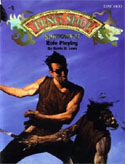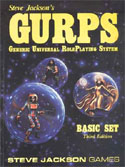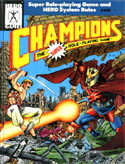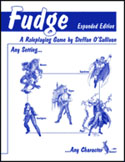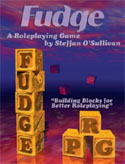Go to Part 1
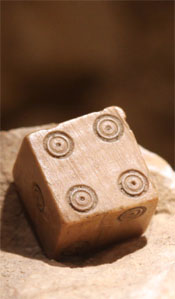 QUALITIES
QUALITIES
TIME REQUIRED: This quality is used to determine the amount of time an action takes to complete. For example, a good roll on this die will indicate that the action took less time for the character to perform. A bad roll on this die will indicate that the action took more time. Of course, the exact amount of time in question is a factor of what type of action is taking place.
OUTSIDE INFLUENCES: This quality is used to determine whether or not outside influences (i.e., things beyond the character’s control and/or experience) had the greatest or least effect on the outcome.
A character is attempting to pick a lock and succeeds, rolling very high on the outside influences die. The GM says, “Well, some day you’re hoping you’ll run into a challenge – but this isn’t it. A clear example of why government contractors should never be hired, the lock clicks open almost immediately.” If, on the other hand, he had had a marginal failure and rolled poorly on the outside influences die, the GM might have said, “Although you do your best, this lock is tough. Clearly a custom-made job, the tumblers have disguised trips and keep slipping off your pick. You might be able to crack it eventually, but you’ll have to start over from ground zero.”
KNOWLEDGE: The knowledge quality addresses that little memory bank everyone carries around with them – high influence from the knowledge die would suggest that either the character possesses some little piece of knowledge that makes the difference (success) or lacks a piece of knowledge that would help them (failure).
To return to our lockpicking example, a character succeeds with the knowledge die having the largest effect on that outcome. The GM might say, “Normally this lock would have been more than adequate security for this type of facility, but you just spent three weeks practicing on a lock off the same assembly line. Within seconds the door swings open.”
SKILL: This one is probably one of the most obvious of the qualities – it refers to the skill of the character and the impact it had on the outcome. If the skill roll was highly beneficial, it means that the character was performing at the best of his ability (even if he still subsequently failed). If the skill roll was extremely poor, it indicates that the character wasn’t doing his best (even if he proceeded to succeed at the action).
Rozel, a character involved in a fencing match attempts to strike his opponent, Benalt, and manages to succeed, although his skill roll is rather low. The GM shakes his head, “Rozel feints to the left and manages to draw Benalt’s block, but then doesn’t come back far enough to right. Only because Benalt’s foot slips does your blade manage to slash across his arm.” On the other hand, if the skill die had been higher, the GM might have said, “Rozel feints expertly to the left and Benalt moves to respond, only to be caught completely off-guard as the tip of your saber loops under his blade and tears a bloody gash into his arm.”
LUCK: Sometimes the biggest reason a character succeeds is because he has gotten lucky. If the most influential die result turns out to be on the luck die the GM should have the resolution of the action come about because of something completely out of the character’s control.
In a science fiction game, Laatzu, a fighter pilot, is attempting to blast one of the evil Bengai’s out of known space with his lasers. He fails, largely due to the poor roll on the die assigned the luck quality. “Laatzu loops his ship in behind the Bengai Tiger Scout and lets loose two searing bolts of death . . . only to meet with disappointment as his expertly placed shots strike an unnoticed piece of space debris.”
STYLE: Unlike the qualities discussed so far, the style quality doesn’t attempt to shed light on how or why something succeeded or failed – but how the success or failure took place. It asks the question, “Just how good did that look?”
Billy the Gangster attempts to leap over a stack of boxes, coming out of a rolling somersault, and fire two shots at some anonymous mug taking shots at his pals on the other side of the warehouse. He rolls a success, despite the abysmal result on the die assigned to style. The GM smirks, “Billy takes a couple of loping steps and leaps over the stack of boxes . . . knocking the top two over, stumbling, and falling flat on his back. His pistol slips out of his hand as he lands and skitters across the floor, sending him after it in a wild crawl. Snapping it up he manages to squeeze off a couple of shots and fill the mug full of lead just before he gets a face full of lead from the shotgun pointed at his head.” On the other hand, Sarah, an acrobat, is trying to walk across a beam. Her action resolution roll is a failure, but her style die is high. “Sarah is crossing the beam when suddenly she feels her balance slip. As she falls off she pushes a little bit with her leg and manages to land gracefully on the floor after a flip instead of falling flat on her butt.”
POWER: Sometimes people succeed just because they put more power into the attempt, or fail because they didn’t. This quality is particularly useful in combat situations.
Conan attacks an NPC with his sword and rolls a success with a particularly beneficial result on his power die. The GM grimaces, “Conan brings his mighty blade around. Although the guard raises his sword to parry it is completely ineffectual as your mighty arms push his blade out of the way and crush his skull.” Alternatively, you might have Gabrielle, a thief with an attitude, throw her dagger at a hapless orc, failing to do any damage with a particularly ineffectual score on her power die. “Your graceful throw is perfectly accurate, but glances ineffectually off the hard leather encircling the orc’s chest.”
FINESSE: This quality reflects on the precision with which a given action was taken, and its impact on success. For example, a poor roll on this die would show clumsiness, while a positive roll on this die would grace and perfection.
The Wizard, a hacker in a Cyberpunk game, is trying to get past some Black ICE which is preventing him from reading the data files he needs to reveal a corporation’s corruption. Rolling a marginal failure on attack he has a particularly poor result on his finesse die. “Getting a little overconfident, huh?” says the gamemaster. “The ICE swallows those simple macros with ease. You’re going to have to have to bring out the big guns if you expect to get past this guy.” Later on he gets a stunning success with a high finesse roll, “Nice work. That blackie was pretty effective, and usually your progs would have had some problems, but by slipping past his I/O channels and hitting his processor directly you take him out, smiling in satisfaction as his data-scream of death reverberates through your skull.”
HIT LOCATION
Using a system similar to that described above for qualities, a simple hit location system can be added to any multi-dice combat resolution (although it probably means removing the normal qualities from combat resolution).
Essentially you assign to each die in the resolution a different hit location. In the case of a successful attack, whichever die was most influential on the outcome (usually the highest roll, although in some systems the lowest) is the location of the hit.
This system, like most hit location systems, works best for humanoid creatures – although it can be easily adapted to non-humanoids.
Although the examples list different possibilities based on the number of dice typically used in the resolution, it’s just as easy to show the likelihood of hitting each location by – for example – having a single die for “head” and two dice each for “torso” and “limbs”.
If the GM wishes to add damage bonuses based on this hit location system he may, or he can simply use it as a descriptive aid like the other qualities.
| 2 dice | Head/Torso, Limbs |
| 3 dice | Head, Torso, Limbs |
| 3 dice | Head/Torso, Arms, Legs |
| 4 dice | Head, Torso, Arms, Legs |
| 5 dice | Head/Torso, Left Arm, Right Arm, Left Leg, Right Leg |
Continued…


